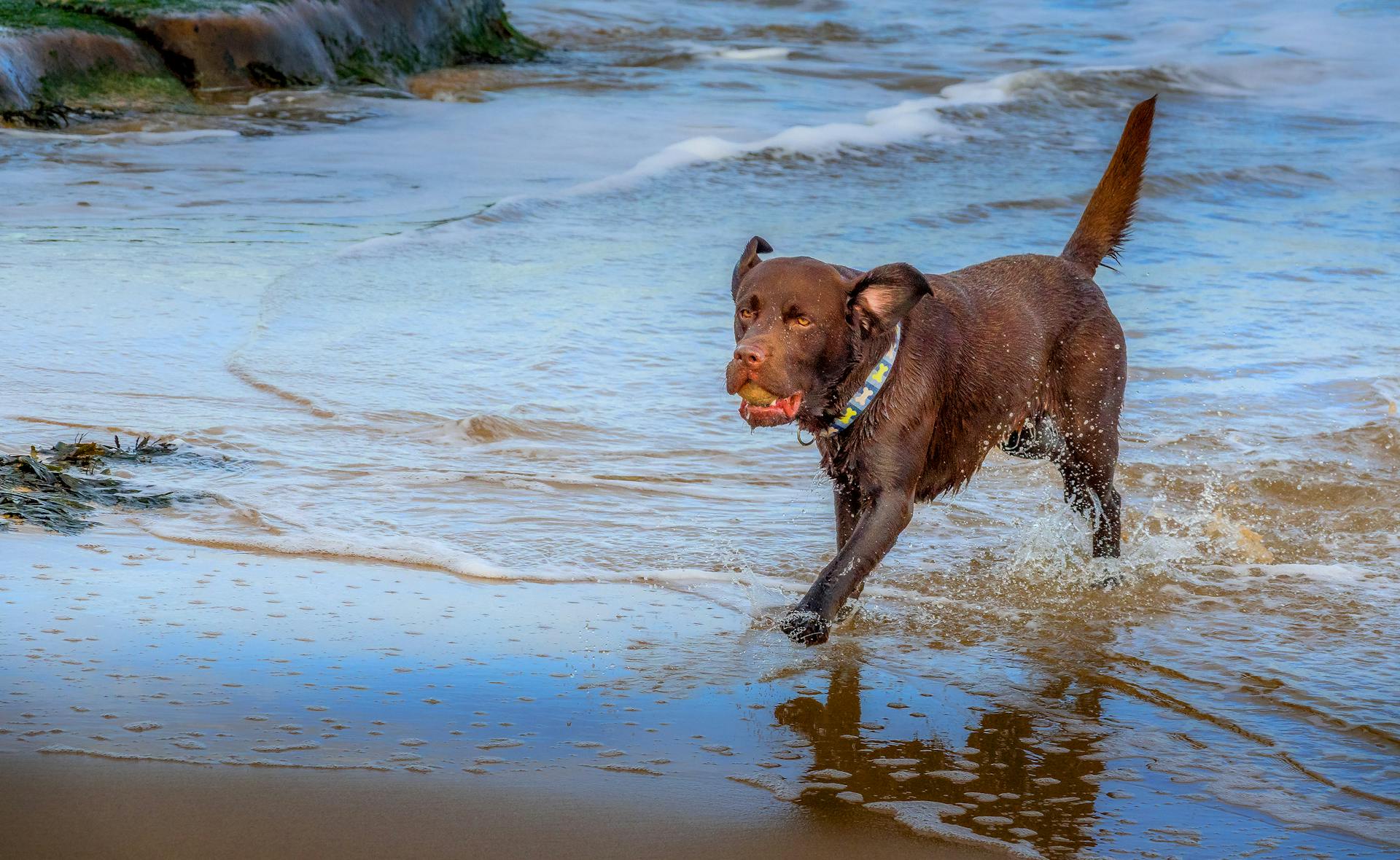
Labradors are naturally drawn to water, thanks to their origins as a waterfowl-hunting breed. They were bred to assist fishermen in Newfoundland, Canada.
Their love for water is partly due to their thick coat, which helps to repel water and keep them warm in cold temperatures. This unique coat is made up of two layers: a thick undercoat and a coarser outer coat.
Labradors are also excellent swimmers, with a strong tail and webbed feet that propel them through the water with ease. Their webbed feet are a key adaptation that allows them to swim efficiently.
In fact, Labradors are often used as rescue dogs during water emergencies, thanks to their natural aptitude for swimming and their strong instinct to retrieve.
Labrador Swimming
Labradors are built for swimming, with a water-resistant double coat that provides insulation and a tail often likened to an otter's, which they use as a powerful rudder.
Their ancestors, the St. John's water dogs, were strong swimmers with well-muscled chests, short, oily coats, and webbed feet. These traits were passed down to modern Labradors, making them excellent natural swimmers.
Labradors have a strong instinct to swim, which is why they love to jump into water and retrieve fish, game, or sticks for their owners. This instinct is rooted in their breeding history, where they were trained to help fishermen retrieve fishing gear and fish.
Some Labradors may not enjoy swimming, but this is not because they are not naturally good swimmers. Instead, it may be due to a lack of experience with water, a bad experience in the past, or simply a matter of personality.
If your Lab isn't interested in the water, you can help by creating new, positive experiences with water. For example, you can start by getting them used to sitting in the tub with the door closed without turning on the water, and then gradually introduce them to swimming.
Here are some tips to help your Lab overcome their fear of water:
- Start with small steps, such as simply sitting by the water's edge or getting them used to the feeling of the water on their paws.
- Gradually increase their exposure to water, such as by having them swim in a kiddie pool or a shallow area of the lake.
- Make sure to provide plenty of positive reinforcement, such as treats and praise, to help them associate water with good experiences.
By following these tips and being patient, you can help your Lab become a confident and happy swimmer.
Swimming Benefits
Swimming is a fantastic way to keep your Labrador happy and healthy.
Their love for water is in their blood - Labs descend from the St. John's water dog breed, which was bred to help fishermen on the coast of Newfoundland, Canada.
Swimming is a low-impact exercise that's great for Labs of all ages, especially those with joint issues. It's also an effective way to burn calories and help maintain a healthy weight.
Swimming strengthens their heart and lungs, making it a great cardiovascular workout.
Here are some physical benefits of swimming for Labradors:
- Joint-friendly: Swimming is a low-impact exercise, making it great for Labs of all ages, especially those with joint issues.
- Weight control: It's an effective way to burn calories and help maintain a healthy weight.
- Cardiovascular health: Swimming strengthens their heart and lungs.
By incorporating swimming into their routine, you'll not only be providing them with exercise, but also helping to prevent destructive behaviors and keeping them relaxed and confident in their place in the pack.
Training and Preparation
Labs are natural swimmers, but they still need to be introduced to water in a safe and controlled manner.
Start training your Labrador to swim when they're young, but after they've had their vaccinations. This is crucial for their health and safety.
A kiddie pool is a great place to start swim training, as it provides a controlled environment for your Lab to get comfortable with water.
Explore further: Can a English Bulldog Swim
Training Your Labrador
Labs are natural swimmers, but they still need to be introduced to water in a safe and controlled manner.
Start by filling up a kiddie pool in your backyard and letting your puppy get his paws wet while you run around on the shore. This will help him get comfortable with the water.
It's essential to wait until your puppy has had his vaccinations before introducing him to public pools, lakes, and other bodies of water where bacteria and other microbes roam free.
A good rule of thumb is to start swim training after your Lab's vaccinations and use a controlled environment like a kiddie pool. This will make the experience positive and fun for your Lab.
Remember, your dog's experiences as a puppy could impact how he perceives the water as an adult, so keep it low-key and fun with relaxed bathtime experiences and backyard shenanigans.
Curious to learn more? Check out: Will a Hearing Aid Battery Kill a Dog
How Long Should I Let My Dog Swim?
Swimming is a fantastic way to exercise your dog, but it's essential to know how long to let them swim to avoid overexertion.
If your dog is a strong swimmer, 30-minute blocks are okay. However, if your dog isn't a strong swimmer, start with 10-minute sessions three to four times a week.
It's also crucial to remember that every dog is different, and some may tire quickly. Always watch for signs your dog is tired or needs a break, and end playtime early if necessary.
Here's a general guideline for swimming sessions:
Remember, it's always better to err on the side of caution and keep your dog's stamina and experience in mind.
General Information
Labrador Retrievers have a natural affinity for water, thanks to their ancestors, the St. John’s Water Dog, who worked in the icy waters off Newfoundland.
Their oily, waterproof double coats keep them dry and comfortable in cold water.
Labradors have webbing between their toes, which helps them paddle through the water with ease.
Their powerful legs propel them forward, making them excellent swimmers.
They can swim for as long as it takes to retrieve waterfowl on a hunt, thanks to their dense, insulating double coats.
For your interest: Double Coated Golden Retriever
Health and Safety
Hypothermia is a concern for dogs, just as it is for humans. If it's too cold for you, it might be too cold for your dog, especially when it comes to water colder than 50 degrees.
Labradors who usually dive in without question may avoid the water if it's too cold, indicating that it's time to call off the training session.
Always supervise your Labrador in the water, as their safety is paramount. This is especially true for their first few swims.
Invest in a dog life jacket, as it can be a lifesaver in case your Labrador gets tired or struggles in the water.
Frequently Asked Questions
Do Labradors like bathing?
Labradors generally enjoy bathing due to their origins as working dogs bred to assist fishermen in water. Their love for water activities is a key characteristic of the breed.
Sources
- https://www.akc.org/expert-advice/lifestyle/breeds-that-are-born-to-swim/
- https://news.orvis.com/dogs/the-best-dog-breeds-for-swimming
- https://www.snowypineswhitelabs.com/blog/do-labs-like-water/
- https://medium.com/@lovelabworld1/why-do-labs-like-the-water-so-much-44538c5ff781
- https://www.petssatisfaction.com/blogs/labrador-retriever-breed-guide/do-labrador-retrievers-like-water
Featured Images: pexels.com


